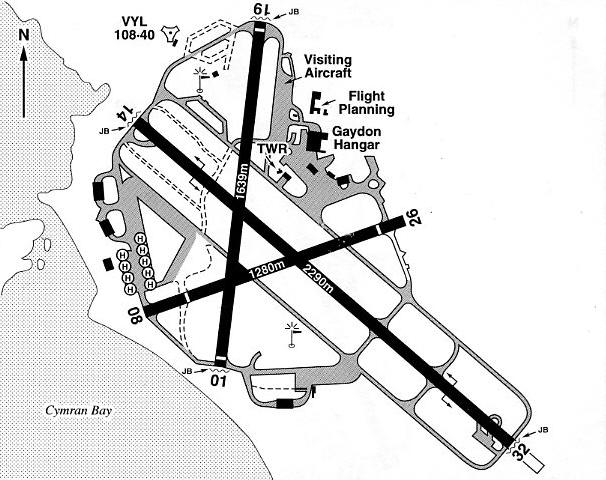Valley
VALLEY: Military aerodrome
(Aka RHOSNEIGR and more recently HOLYHEAD AIRPORT and ANGLESEY AIRPORT)
ICAO code: EGOV
Military users: WW2: RAF Fighter Command 9 Group
312 & 615 Sqdns (Hawker Hurricanes)
219 Sqdn (Bristol Beaufighters)
456 RAAF Sqdn (Bolton Paul Defiants, then Bristol Beaufighters, later DH Mosquitos)
Note: It is said that this Royal Australian Air Force squadron was the only RAAF night fighter squadron during WW2.
RAF Coastal Command (ASR - Air-Sea Rescue):
275 Sqdn (Avro Ansons, Boulton Paul Defiants, Supermarine Walrus’, Vickers-Supermarine Spitfires & Westlands Lysanders)
RAF Transport Command 44 Group
1528 BAT Flt (Airspeed Oxfords)
USAAF: 414th Night Fighter Squadron (Bristol Beaufighters)
Post 1945: RAF Training Command:
'V' Bomber dispersal airfield
208 AFS [Advanced Flying School] (de Havilland DH100 Vampire FB Mk5)
4 FTS
202 FTS
1 Sqdn (Folland Gnats, later BAe Hawks)
SAR Training Unit 19 (R), 22 Sqdn (Wessex), 60(R), 74 (R) and 208(R) Squadrons
1975: (Folland Gnats, Hawker Hunters & Westland Whirlwind helicopters)
1998 snapshot: RAF Flying Training (Advanced)
19 (R) Sqdn (4 FTS) 24 x Hawk T 1/1A
60 (R) Sqdn (DHFS) 3 x Griffin HT 1 (Shared with RAF SHAWBURY)
74 (R) Sqdn (4 FTS) 24 x Hawk T 1/1A
208 (R) Sqdn (4 FTS) 24 x Hawk T 1/1A
British airline users: Manx2*
Location: E to NE of Cyntyran Bay, 5.5nm SE of Holyhead
Period of operation: 1941 to present day
Note: This map is reproduced with the kind permission of Pooleys Flight Equipment Ltd. Copyright Robert Pooley 2014.
Runways: WW2: 18/36 1632x46 hard 07/25 1280x46 hard
13/31 1829x46 hard
1990/2000: 01/19 1639x46 hard 08/26 1280x46 hard
14/32 2290x46 hard
NOTES: In late 1944 VALLEY has been listed as being an airport by RAF Transport Command or so it seems! Perhaps the confusion arises because RAF VALLEY was a ‘terminal’ for ‘Operation TRANSAT’ in late 1943 and used by considerable numbers of USAAF bombers crossing the Atlantic en route to the UK before being deployed to operational stations on the east side of England. When WW2 ended the flow reversed and it seems something like 2,600 bombers staged through VALLEY on their return to the USA.
THE POST WAR ERA
Arguably the most significant event to occur here after WW2 was when a group of instructors of No.4 FTS (Flying Training School), led by Flight Lieutenant Lee Jones, decided to form a formation aerobatic team known as ‘The Yellowjacks’, with their Folland Gnat T.1 aircraft painted a gawdy lemon yellow. They were a sensation, especially when demonstrating their speciality, the ‘twinkle roll’. Indeed, it was claimed a Gnat could perform a 360° roll faster than an estate agent could calculate their commission – so, bordering on a nanosecond obviously.
It appears that the rate of roll of the Folland Gnat was so fantastic that it needed, according to less inspired people higher up in the RAF, to be inhibited and something was incorporated to achieve this, which had an electrical element – and therefore a fuse installed. I can clearly recall seeing an interview with a Yellowjack pilot, almost certainly Flt. Lt Lee Jones, who explained that by “pulling the fuse” the ‘twinkle roll’ was still achievable. Apparently some top knob RAF officer saw a display and immediately ordered the fuse to be replaced.
And this the team diligently did, as, orders is orders in the military and must never be disobeyed. However – the dictate did not specify that serviceable fuses had to be used – so ‘twinkle rolls’ continued to be displayed for some time after.
The seven Gnats of the Yellowjack display team were handed over, in 1964, to the now single official RAF Aerobatic Team, repainted and known throughout the world as ‘The Red Arrows’.
THE ARGOSY MYSTERY?
Although generally reckoned to be based at RAF BENSON one AW.650 Argosy C.1 was based here it seems - but for how long? And, what did it do?
TIGER MOTHS
It appears that in 1977 the DH.82A Tiger Moths G-ANRF and G-ARTO (?) were based here but neither in flying condition it seems. Is there a story attached?
THE HAWK ERA
The RAF have been flying BAe Hawk trainers from here since November 1976. Writing this in April 2014, that makes for the thick end of thirty eight years! From several sources it has been claimed the Hawk trainer, obviously with a very capable pilot, can outfly in combat virtually every other type of fighter. The problem being presumably that when it needs to go home, everything else is faster.
A SMALL OBSERVATION
It is just a tiny point but amazingly all three runways in 2000 had their headings in the next ten degree sector. Is this unique in the UK for aerodromes with three runways?
The runway dimensions are also remarkably similar to the WW2 sizes too, another very unusual feature of UK military aerodromes at least.
1998 snapshot: RAF Search and Rescue
C Flight (22 Sqdn) 2 x Westland Sea King HAR 3A
*I think the introduction of a scheduled service by Manx2 (mainly to serve members of the Welsh Assembly from Cardiff in 2008?) was the first and only airline service into this site?
SOMETHING OF INTEREST?
This relates to 208 Squadron becoming established here, at the end of a very long RAF career starting in WW1. After making a small contribution I was very kindly sent a copy of 'Two / Six', (ISBN 978 1789017 090), a biography of S E Jefford who served with 208 Squadron throughout WW2 as 'ground crew' - albiet as a highly qualified technician specialising in engines.
The more I read, the more it became fascinating. One of the very few books dedicated to our many unsung heroes - those that kept the aircraft flying. Often in appalling conditions we can barely envisage as being possible today.
We'd love to hear from you, so please scroll down to leave a comment!
Leave a comment ...
Copyright (c) UK Airfield Guide
















